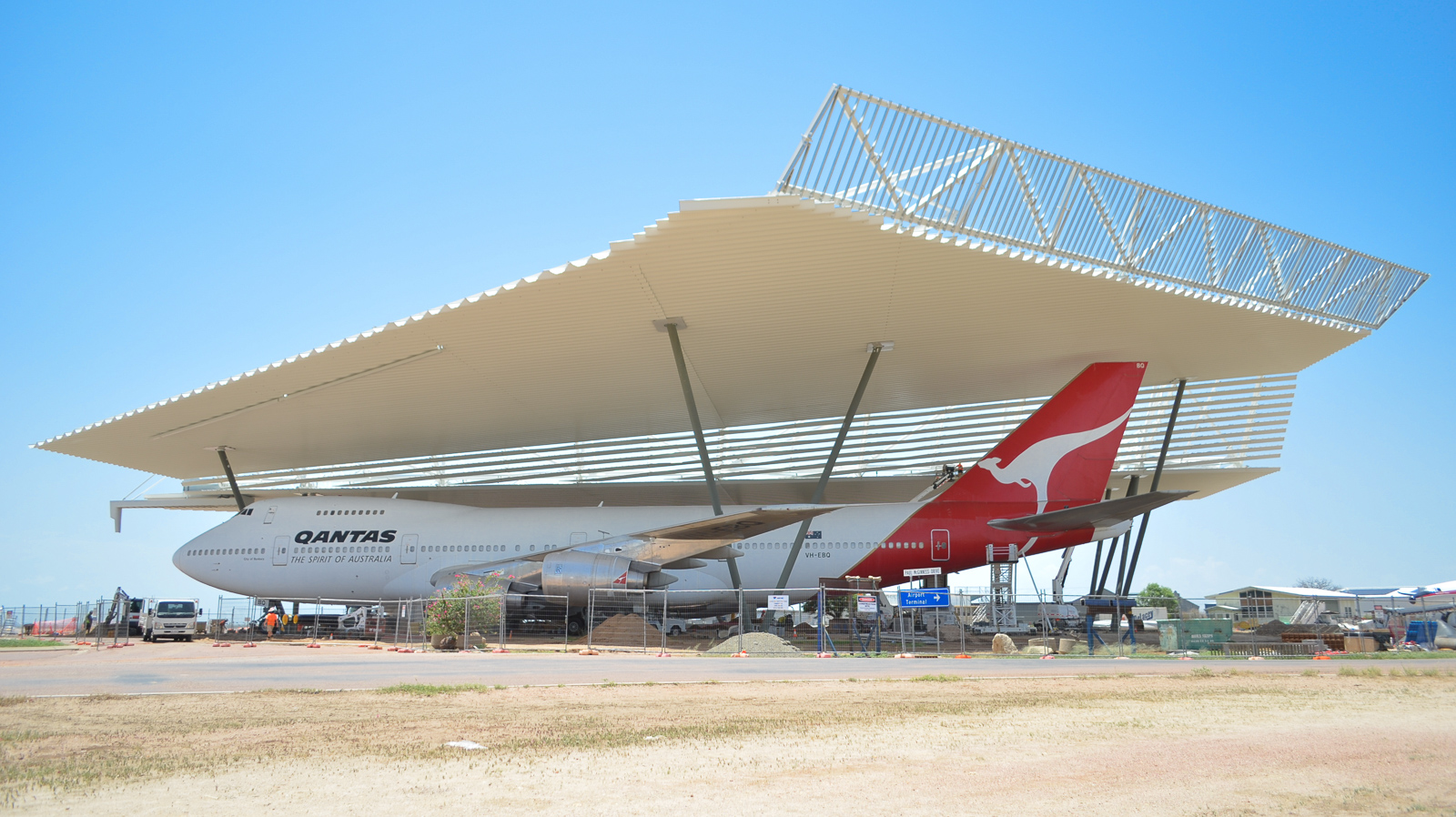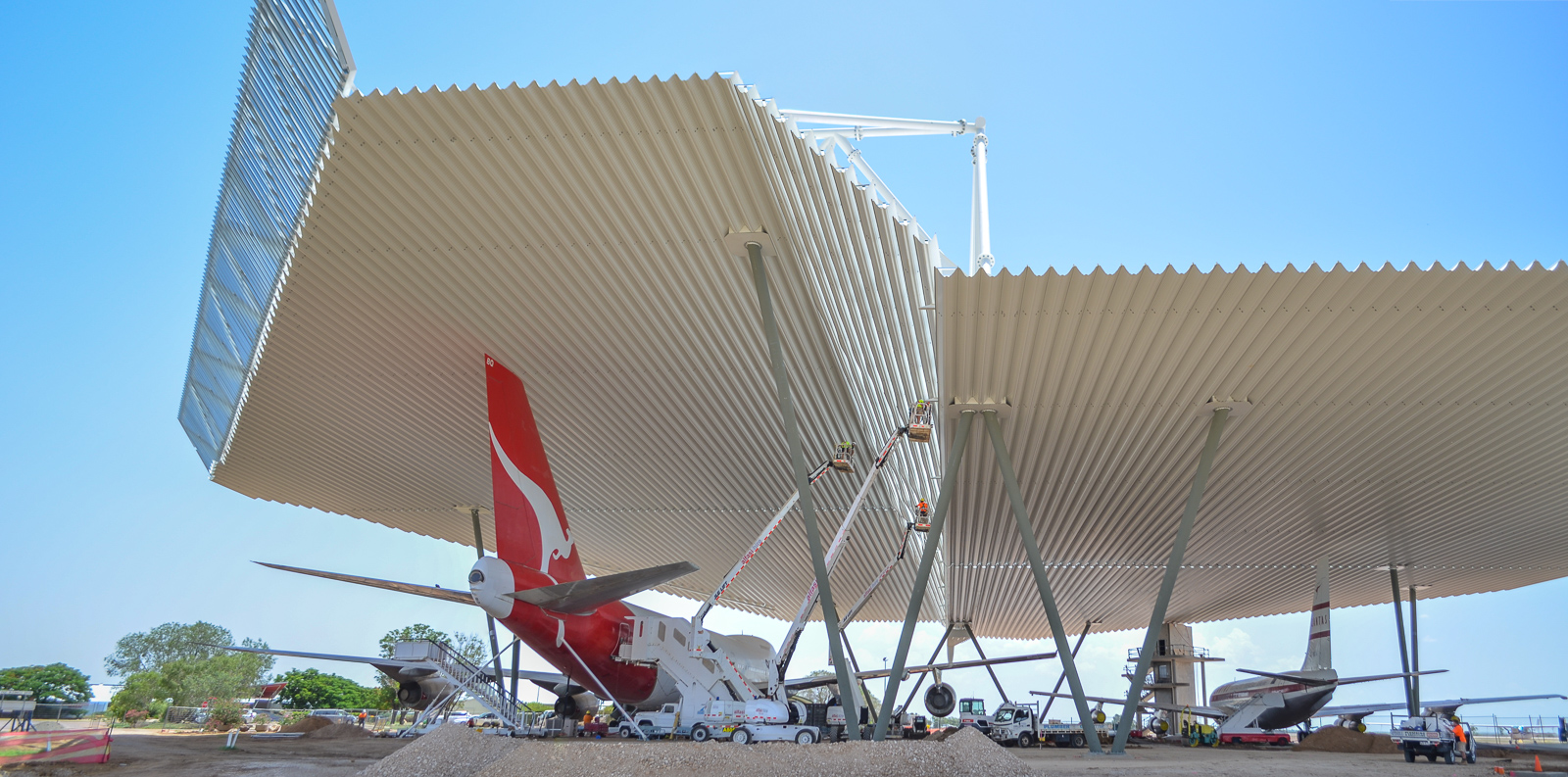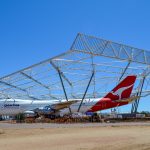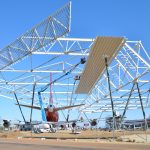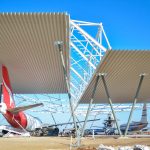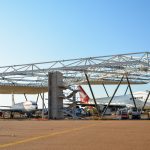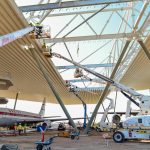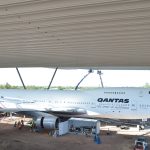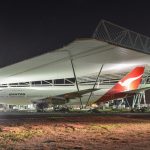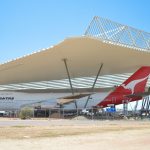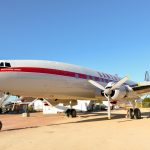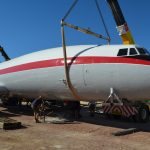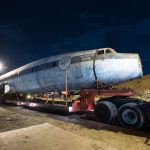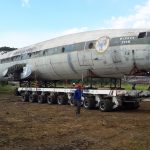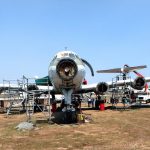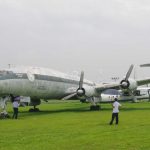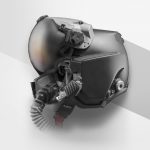While this story is slightly outside of our usual coverage, we feel that it offers potentially vital solutions for the longterm preservation of truly large aircraft such as four-engined airliners or military cargo planes. While such aircraft are relatively plentiful today, it will be nearly impossible to save many examples far into the future without bringing them undercover. But a traditional museum building of the scale needed to house such a beast is well beyond the means of all but a handful of facilities worldwide, and even then, it is hard for them to justify the massive expenditures involved in such an endeavor. However, following the Museum of Flight’s lead with the construction of their Aviation Pavilion in Seattle, Washington a few years ago, the Qantas Founders Museum at Longreach in Queensland, Australia has pursued a similar path with their elegant Airpark Roof Project. This newly-completed structure now offers protection to their Boeing 747 and 707 airliners, amongst others. While this effort will not completely protect these large aircraft from the environment, it will at least keep the most brutal effects of exposure to rain, wind, sand and the sun at manageable levels, and do so in a cost-effective way. As the images also show, this effort can also be undertaken in an aesthetically pleasing manner that offers benefits to a museum’s function beyond simple artifact preservation. The following press release from the Qantas Founders Museum describes this effort in more detail, and we hope it provides useful ideas for other institutions around the world facing a similar dilemma with the preservation of their own over-sized airframes…
Major Stage of Airpark Roof Covered
Qantas Founders Museum’s iconic Boeing 707 and Boeing 747 aircraft are now under cover, with the last of the Airpark Roof Project’s Aramax Sheeting installed.
Work began on the Aramax Roof installation in November 2019 with the teams securing the sheeting working through and managing under tough conditions including Summer heat, high winds, bugs, sand flies and more.
All the Roof work, including lifting and positioning the structural steel, the Roof sheeting and the groundworks has been carefully undertaken around the Boeing 707 and Boeing 747, as they are firmly secured to their substantial foundations within the Airpark footprint.
Museum CEO Tony Martin said the benefits of the Airpark Roof cover were already evident.
“This is a major stage of the project and to see it completed is very exciting as we are one step closer to officially opening this incredible facility,” Mr Martin said.
“With two of our largest iconic aircraft now covered, we can already see the difference the roof will make in the ongoing preservation of these aircraft, the visitor experience on guided tours during the day and the Light & Sound show and evening functions at night.”
“With completion of the Roof and Light & Sound show, all coming to fruition during the Qantas Centenary Year celebrations, we expect to see a significant and sustained increase in the number of museum visitors and that this will also encourage visitors to stay longer in the Central West region which has so many attractions to offer.”
The DC-3 aircraft was moved from the area during construction, and both it and the Museum’s stunningly presented Super Constellation aircraft will be located under the Roof and fully displayed once the final works activities are completed.
Here are some interesting facts for this stage of the project:
- The Airpark Roof covers an area of 8072m2, half as big as the Sydney Cricket Ground;
- The Roof height reaches 26 meters
- This stage of project has taken 5 months to complete
- Approximately 13km of roof sheeting or 24 tonnes was lifted into position to form the roof
- Some pieces of Aramax sheeting are up to 54 metres long and all have been rolled on-site from flat aluminium sheet
- Up to 17 people installed the roof using six boom lifts and working around and over the Boeing 747 and 707
- Each piece of sheeting took an average of two hours to install
- In February 2020, two teams were employed to install the sheeting with the first shift working from 6am – 4pm and the second crew from 4pm – 2am
- Teams have been working in trying conditions including higher summer temperatures, unseasonable winds, flies and bugs
- During this stage the construction of the 9m viewing platform and service reticulation also commenced
- The 9m platform providing stunning views over the aircraft and the surrounding town and country.
While this stage of the project is complete, there is still much activity happening including:
- The laying of concrete pathways for the tour groups;
- Installation of the inground services for the light and sound show and night functions
- Laying of tie-down footings and relocation of the Super Constellation into position
- Construction of a rainwater catchment sculpture and drainage to direct rain water from the roof
- Painting of the viewing platform and lift shaft, footings, construction of seating, fencing and landscaping
- Installation and testing of the light and sound show
- Installation of the lift to the viewing platform.
ABOUT THE AIRPARK ROOF PROJECT
Qantas Founders Museum’s Airpark Roof Project is an ambitious $14.3 million two stage project to create a unique night experience using sound and light projected on the fuselage of the iconic Boeing 747, Boeing 707, Super Constellation aircraft and an 8072m2 roof.
Stage One of the Project includes the construction of a 8072m2 roof and lighting for night tours, footpaths, landscaping and fencing.
Once completed the roof will provide protection to the Museum’s visitors and aircraft during the day and provide an all-weather venue for expanded visitor experiences.
Stage One is fully funded by the Australian Government as a Community Development Grants Project.
Stage Two of the project includes a state of the art light and sound show night experience, telling the story of Qantas’ origins projected onto the aircraft and the only one of its kind in Queensland, and the construction of a nine metre high viewing platform and lift.
Stage Two of the project is supported by the Queensland Government as a Growing Tourism Infrastructure Grant project.
Following an extensive period of collaboration between the Museum and architects NRA Collaborative, initial preparation work for the project began in April 2019 before the official Sod Turning Ceremony in May 2019.
On 2 September 2019, Qantas Founders Museum officially handed over the Airpark site, which includes the Museum’s Boeing 747 and Boeing 707, to building contractors Watpac.
The project is expected to be completed in April 2020 with an official launch on 20 June 2020 at the Red & White Gala. The timing of the completion of this project is planned to coincide with Qantas Centenary Celebrations.
The Airpark Roof and Light & Sound show night experience, being developed in collaboration with Buchan, is expected to increase Museum visitors by 24% by 2021.
The Airpark Roof and Light & Sound show is the largest project that the Qantas Founders Outback Museum has undertaken since its establishment in the National Heritage Listed Qantas Hangar in 1996, before expanding to the main modern Museum in 2002.
During the Project’s construction the Museum will continue to operate as normal. Museum visitors can still enjoy the many exhibits and displays in the Main Museum precinct, the Captain’s Tour and guided tours of the National Heritage Listed Qantas Hangar. For more information go to the Museum’s Admissions Page.
ABOUT QANTAS FOUNDERS MUSEUM
Qantas Founders Museum is a not for profit organisation which tells the story of Australia’s national airline, Qantas Airways, and how it began in Western Queensland in 1920. The museum, which has an annual visitation of 47,000 people, holds a variety of exhibits, interactive displays, artifacts and aircraft including an original Qantas Boeing 747-238, Qantas’ first Boeing 707-138, a DC-3, a Super Constellation and a Catalina flying boat together with replicas of early-era aircraft. To donate to the Museum and its projects, please click HERE and follow the links or contact the museum by phone on: 07 4658 3737 or email: [email protected].







